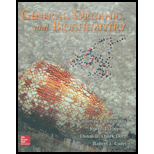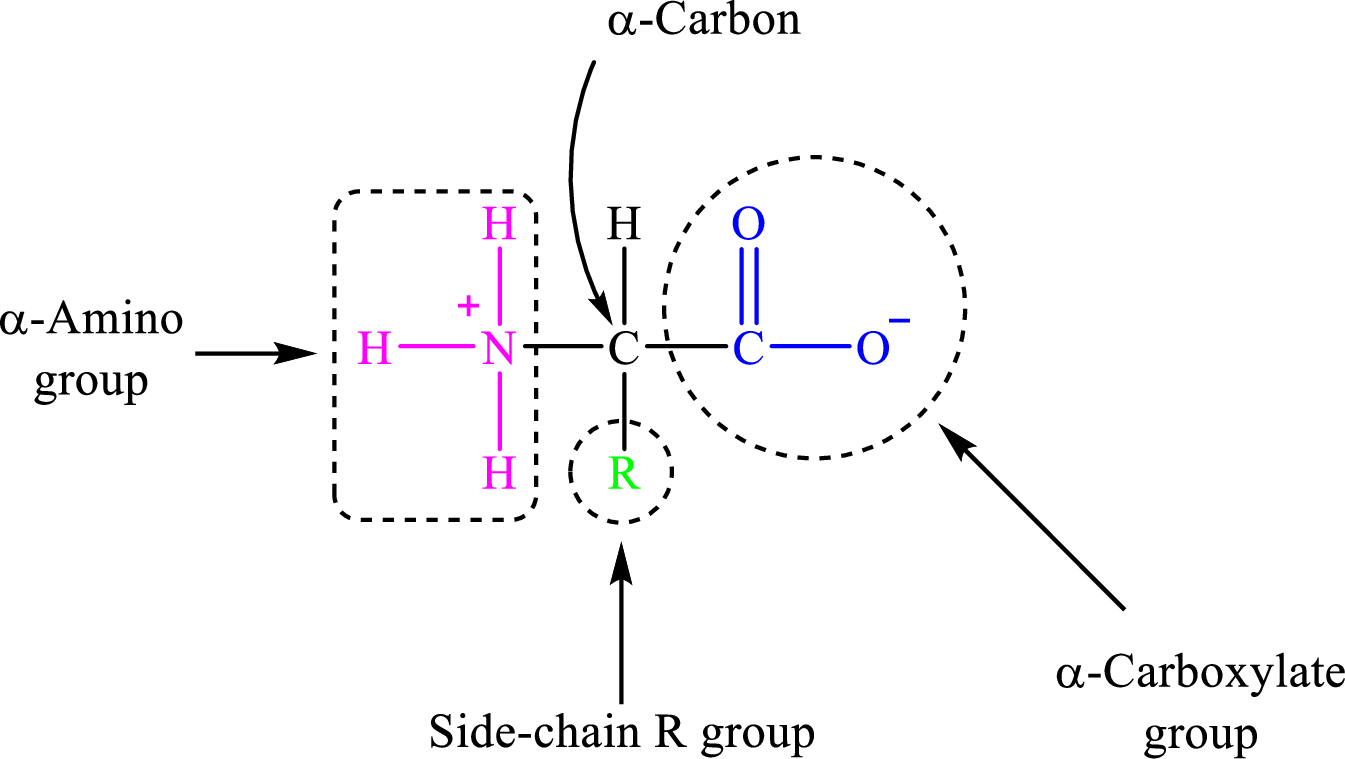
GENERAL,ORGANIC,+BIOCHEM.(LL) >CUSTOM<
10th Edition
ISBN: 9781264116546
Author: Denniston
Publisher: MCG CUSTOM
expand_more
expand_more
format_list_bulleted
Question
Chapter 18, Problem 18.25QP
Interpretation Introduction
Interpretation:
The term zwitterion has to be explained.
Concept Introduction:
The general structure of

Expert Solution & Answer
Want to see the full answer?
Check out a sample textbook solution
Students have asked these similar questions
111
Carbonyl Chem
Choosing reagants for a Wittig reaction
What would be the best choices for the missing reagents 1 and 3 in this synthesis?
1. PPh3
3
1
2
2. n-BuLi
• Draw the missing reagents in the drawing area below. You can draw them in any arrangement you like.
Do not draw the missing reagent 2. If you draw 1 correctly, we'll know what it is.
• Note: if one of your reagents needs to contain a halogen, use bromine.
Explanation
Check
Click and drag to start drawing a structure.
×
©2025 McGraw Hill LLC. All Rights Reserved. Terms of Use
A student proposes the transformation below in one step of an organic synthesis. There may be one or more reactants missing from the left-hand side, but there
are no products missing from the right-hand side. There may also be catalysts, small inorganic reagents, and other important reaction conditions missing from
the arrow.
• Is the student's transformation possible? If not, check the box under the drawing area.
. If the student's transformation is possible, then complete the reaction by adding any missing reactants to the left-hand side, and adding required catalysts,
inorganic reagents, or other important reaction conditions above and below the arrow.
• You do not need to balance the reaction, but be sure every important organic reactant or product is shown.
+
T
X
O
O
лет-ле
HO
OH
HO
OH
This transformation can't be done in one step.
Determine the structures of the missing organic molecules in the following reaction:
X+H₂O
H*
H+
Y
OH
OH
Note: Molecules that share the same letter have the exact same structure.
In the drawing area below, draw the skeletal ("line") structures of the missing organic molecules X and Y. You may draw the structures in any arrangement
that you like, so long as they aren't touching.
Click and drag to start drawing a structure.
X
S
Chapter 18 Solutions
GENERAL,ORGANIC,+BIOCHEM.(LL) >CUSTOM<
Ch. 18.2 - Write the one-letter and three-letter...Ch. 18.2 - Prob. 18.2QCh. 18.3 - Write the structure of each of the following...Ch. 18.3 - Write the structure of each of the following...Ch. 18.3 - Write the structure of each of the following...Ch. 18.7 - Describe the four levels of protein structure.
Ch. 18.7 - Prob. 18.6QCh. 18.9 - Prob. 18.7QCh. 18.9 - Prob. 18.8QCh. 18.11 - Prob. 18.9Q
Ch. 18.11 - How does extremely low pH cause proteins to...Ch. 18.12 - Prob. 18.11QCh. 18.12 - Prob. 18.12QCh. 18 - Prob. 18.13QPCh. 18 - Prob. 18.14QPCh. 18 - Prob. 18.15QPCh. 18 - Prob. 18.16QPCh. 18 - Prob. 18.17QPCh. 18 - Prob. 18.18QPCh. 18 - Prob. 18.19QPCh. 18 - Prob. 18.20QPCh. 18 - Prob. 18.21QPCh. 18 - Prob. 18.22QPCh. 18 - Describe the basic general structure of an...Ch. 18 - Prob. 18.24QPCh. 18 - Prob. 18.25QPCh. 18 - Prob. 18.26QPCh. 18 - Prob. 18.27QPCh. 18 - Prob. 18.28QPCh. 18 - Prob. 18.29QPCh. 18 - Prob. 18.30QPCh. 18 - Prob. 18.31QPCh. 18 - Prob. 18.33QPCh. 18 - Prob. 18.63QPCh. 18 - Prob. 18.64QPCh. 18 - Prob. 18.65QPCh. 18 - Prob. 18.66QPCh. 18 - Prob. 18.67QPCh. 18 - Prob. 18.68QPCh. 18 - Prob. 18.69QPCh. 18 - Prob. 18.70QPCh. 18 - Prob. 18.71QPCh. 18 - Prob. 18.72QPCh. 18 - Prob. 18.73QPCh. 18 - Prob. 18.74QPCh. 18 - Carbon monoxide binds tightly to the heme groups...Ch. 18 - Prob. 18.76QPCh. 18 - Prob. 18.77QPCh. 18 - Prob. 18.78QPCh. 18 - Prob. 18.79QPCh. 18 - Prob. 18.80QPCh. 18 - Prob. 18.81QPCh. 18 - Prob. 18.82QPCh. 18 - Prob. 18.85QPCh. 18 - Prob. 18.86QPCh. 18 - Prob. 18.87QPCh. 18 - Prob. 18.88QPCh. 18 - Prob. 18.89QPCh. 18 - Prob. 18.90QPCh. 18 - Prob. 18.91QPCh. 18 - Prob. 18.92QPCh. 18 - Prob. 18.93QPCh. 18 - Prob. 18.94QPCh. 18 - Prob. 18.95QPCh. 18 - Prob. 18.96QPCh. 18 - Why is it necessary to mix vegetable proteins to...Ch. 18 - Prob. 18.98QPCh. 18 - Prob. 18.99QPCh. 18 - Prob. 18.100QPCh. 18 - Prob. 1MCPCh. 18 - Consider the Chapter Map, and explain the...Ch. 18 - Tardigrades, also known as water bears, are...Ch. 18 - Calculate the length of an α-helical polypeptide...Ch. 18 - Proteins involved in transport of molecules or...Ch. 18 - The α-keratin of hair is rich in the amino acid...Ch. 18 - Calculate the number of different pentapeptides...
Knowledge Booster
Similar questions
- Predict the major products of this organic reaction. If there aren't any products, because nothing will happen, check the box under the drawing area instead. No reaction. HO. O :☐ + G Na O.H Click and drag to start drawing a structure. XS xs H₂Oarrow_forwardWhat are the angles a and b in the actual molecule of which this is a Lewis structure? H H C H- a -H b H Note for advanced students: give the ideal angles, and don't worry about small differences from the ideal groups may have slightly different sizes. a = b = 0 °arrow_forwardWhat are the angles a and b in the actual molecule of which this is a Lewis structure? :0: HCOH a Note for advanced students: give the ideal angles, and don't worry about small differences from the ideal that might be caused by the fact that different electron groups may have slightly different sizes. a = 0 b=0° Sarrow_forward
- Determine the structures of the missing organic molecules in the following reaction: + H₂O +H OH O OH +H OH X Note: Molecules that share the same letter have the exact same structure. In the drawing area below, draw the skeletal ("line") structure of the missing organic molecule X. Click and drag to start drawing a structure.arrow_forwardIdentify the missing organic reactant in the following reaction: x + x O OH H* + ☑- X H+ O O Х Note: This chemical equation only focuses on the important organic molecules in the reaction. Additional inorganic or small-molecule reactants or products (like H₂O) are not shown. In the drawing area below, draw the skeletal ("line") structure of the missing organic reactant X. Click and drag to start drawing a structure. Carrow_forwardCH3O OH OH O hemiacetal O acetal O neither O 0 O hemiacetal acetal neither OH hemiacetal O acetal O neither CH2 O-CH2-CH3 CH3-C-OH O hemiacetal O acetal CH3-CH2-CH2-0-c-O-CH2-CH2-CH3 O neither HO-CH2 ? 000 Ar Barrow_forward
- What would be the best choices for the missing reagents 1 and 3 in this synthesis? 1. PPh3 2 2. n-BuLi 3 Draw the missing reagents in the drawing area below. You can draw them in any arrangement you like. • Do not draw the missing reagent 2. If you draw 1 correctly, we'll know what it is. • Note: if one of your reagents needs to contain a halogen, use bromine. Explanation Check Click and drag to start drawing a structure.arrow_forwardPredict the products of this organic reaction: NaBH3CN + NH2 ? H+ Click and drag to start drawing a structure. ×arrow_forwardPredict the organic products that form in the reaction below: + OH +H H+ ➤ ☑ X - Y Note: You may assume you have an excess of either reactant if the reaction requires more than one of those molecules to form the products. In the drawing area below, draw the skeletal ("line") structures of the missing organic products X and Y. You may draw the structures in any arrangement that you like, so long as they aren't touching. Click and drag to start drawing a structure. Garrow_forward
- Predict the organic products that form in the reaction below: OH H+ H+ + ☑ Y Note: You may assume you have an excess of either reactant if the reaction requires more than one of those molecules to form the products. In the drawing area below, draw the skeletal ("line") structures of the missing organic products X and Y. You may draw the structures in any arrangement that you like, so long as they aren't touching. Click and drag to start drawing a structure. ✓ marrow_forwardDetermine the structures of the missing organic molecules in the following reaction: + H₂O +H H+ Y Z ☑ ☑ Note: Molecules that share the same letter have the exact same structure. In the drawing area below, draw the skeletal ("line") structures of the missing organic molecules X, Y, and Z. You may draw the structures in any arrangement that you like, so long as they aren't touching. Molecule X shows up in multiple steps, but you only have to draw its structure once. Click and drag to start drawing a structure. AP +arrow_forwardPlease help, this is all the calculations i got!!! I will rate!!!Approx mass of KMnO in vial: 3.464 4 Moss of beaker 3×~0. z Nax200: = 29.9219 Massof weacerv after remosimgain N2C2O4. Need to fill in all the missing blanks. ง ง Approx mass of KMnO4 in vials 3.464 Mass of beaker + 3x ~0-304: 29.9219 2~0.20 Miss of beaker + 2x- 29.7239 Mass of beaker + 1x~0.2g Naz (204 29-5249 Mass of beaver after removing as qa Na₂ C₂O T1 T2 T3 Final Buiet reading Initial butet reading (int)) Hass of NaOr used for Titration -reading (mL) calculation Results: 8.5ml 17mL 27.4mL Oml Om Oml T1 T2 T3 Moles of No CO Moles of KMO used LOF KM. O used Molenty of KMNO Averagem Of KMOWLarrow_forward
arrow_back_ios
SEE MORE QUESTIONS
arrow_forward_ios
Recommended textbooks for you
 ChemistryChemistryISBN:9781305957404Author:Steven S. Zumdahl, Susan A. Zumdahl, Donald J. DeCostePublisher:Cengage Learning
ChemistryChemistryISBN:9781305957404Author:Steven S. Zumdahl, Susan A. Zumdahl, Donald J. DeCostePublisher:Cengage Learning ChemistryChemistryISBN:9781259911156Author:Raymond Chang Dr., Jason Overby ProfessorPublisher:McGraw-Hill Education
ChemistryChemistryISBN:9781259911156Author:Raymond Chang Dr., Jason Overby ProfessorPublisher:McGraw-Hill Education Principles of Instrumental AnalysisChemistryISBN:9781305577213Author:Douglas A. Skoog, F. James Holler, Stanley R. CrouchPublisher:Cengage Learning
Principles of Instrumental AnalysisChemistryISBN:9781305577213Author:Douglas A. Skoog, F. James Holler, Stanley R. CrouchPublisher:Cengage Learning Organic ChemistryChemistryISBN:9780078021558Author:Janice Gorzynski Smith Dr.Publisher:McGraw-Hill Education
Organic ChemistryChemistryISBN:9780078021558Author:Janice Gorzynski Smith Dr.Publisher:McGraw-Hill Education Chemistry: Principles and ReactionsChemistryISBN:9781305079373Author:William L. Masterton, Cecile N. HurleyPublisher:Cengage Learning
Chemistry: Principles and ReactionsChemistryISBN:9781305079373Author:William L. Masterton, Cecile N. HurleyPublisher:Cengage Learning Elementary Principles of Chemical Processes, Bind...ChemistryISBN:9781118431221Author:Richard M. Felder, Ronald W. Rousseau, Lisa G. BullardPublisher:WILEY
Elementary Principles of Chemical Processes, Bind...ChemistryISBN:9781118431221Author:Richard M. Felder, Ronald W. Rousseau, Lisa G. BullardPublisher:WILEY

Chemistry
Chemistry
ISBN:9781305957404
Author:Steven S. Zumdahl, Susan A. Zumdahl, Donald J. DeCoste
Publisher:Cengage Learning

Chemistry
Chemistry
ISBN:9781259911156
Author:Raymond Chang Dr., Jason Overby Professor
Publisher:McGraw-Hill Education

Principles of Instrumental Analysis
Chemistry
ISBN:9781305577213
Author:Douglas A. Skoog, F. James Holler, Stanley R. Crouch
Publisher:Cengage Learning

Organic Chemistry
Chemistry
ISBN:9780078021558
Author:Janice Gorzynski Smith Dr.
Publisher:McGraw-Hill Education

Chemistry: Principles and Reactions
Chemistry
ISBN:9781305079373
Author:William L. Masterton, Cecile N. Hurley
Publisher:Cengage Learning

Elementary Principles of Chemical Processes, Bind...
Chemistry
ISBN:9781118431221
Author:Richard M. Felder, Ronald W. Rousseau, Lisa G. Bullard
Publisher:WILEY